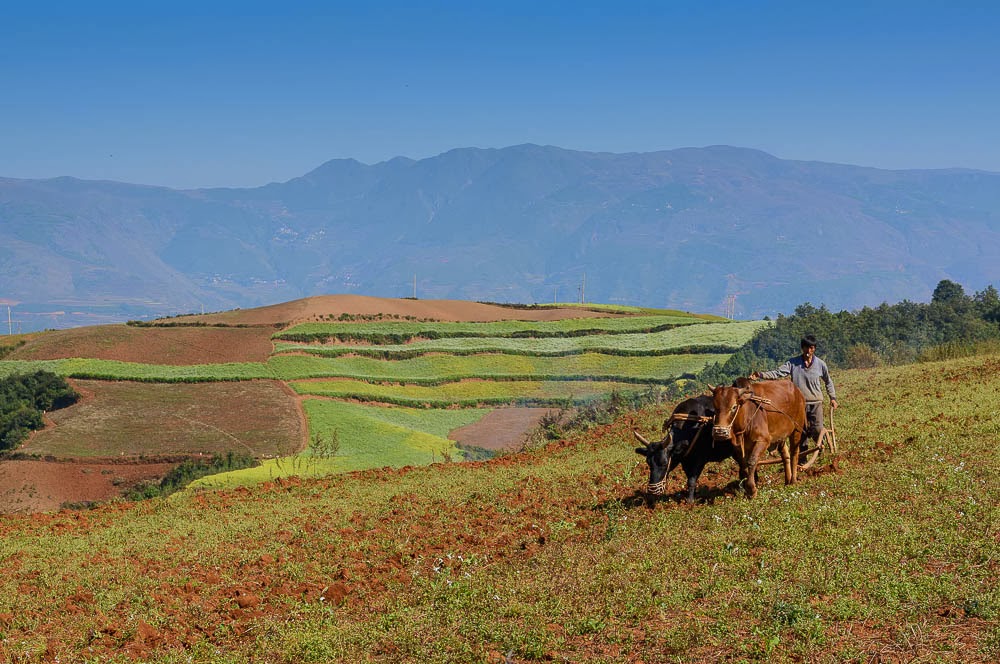It still exists - the old China - but you have to get away from the centers, the big cities. Out into the country. The Southwest of China not only offers unique landscapes. It is also home of various minorities. China is incredibly diverse. On my trip last October I have seen a small part of it. Aside from the beaten track. With local guides, who know the country and people who enabled me to get in touch with the people.
Guilin und Yangshuo
Guilin is famous for its unique karst mountains. Numerous hills rise conical or narrow as columns of the flat surface and form a unique panorama. Daxu, a small village on the Lijiang River is located about 20km southeast of Guilin and has largely remained authentic. In Yangshuo I'm doing a bamboo raft trip on the Yulong River, a quiet tributary of the Li River, through the fantastic karst landscape.
Guilin is famous for its unique karst mountains. Numerous hills rise conical or narrow as columns of the flat surface and form a unique panorama. Daxu, a small village on the Lijiang River is located about 20km southeast of Guilin and has largely remained authentic. In Yangshuo I'm doing a bamboo raft trip on the Yulong River, a quiet tributary of the Li River, through the fantastic karst landscape.
Rice terraces of Longsheng
The next stop is Longsheng Longji-terrace with rice-fields that form a magnificent attraction, glowing in different shades of green. I spend the night the middle of the rice terraces in the Lian-Lodge, a fantastically beautiful hotel. Longsheng is also home to the Dong, a small minority. The women of the Dong cut their hair only once in life when they get married. Open the hair reach to the bottom. Pinned up, they are the pride of this minority.
Wind and Rain Bridges of Sanjiang
The village Ba'ao is home to the Dong minority. They are known for the unique architecture of its wind and rain bridges, where always 5 pavilions are connected by corridors. As almost everywhere in China gambling isof great importance. In each village you can see men gambling.
After a flight to Kunming I drive about 160 km north-east to the town Donchuan. From there I continue to "Hong tu di", which means "red earth". An area which is by tourist standards largely undeveloped and very simple. The time seems to have stopped long time ago. The beautifully arranged fields are cultivated with wooden plow and oxen or horses. The Guide has just a hand-drawn map and has to ask for the way. Also the accommodation and the food is very simple!
Lijiang
After an exciting time it goes back to Kunming and from there by plane to Lijiang. The UNESCO World Heritage city is an attraction to hundreds of thousands of Chinese tourists. After the initial shock, the local guide "abducted" me, into the "backyards" of the city, where life is still unspoilt. The minority "Naxi" are seen in their traditional dresses and elderly women meet at the market place for morning exercises.
Liming
About three-hour drive from Lijiang lies Liming. In the near Laojunshan National Park lies the "Thousand turtles mountain", an unparalleled rock formation that is similar to the armor of thousands of turtles. Over a thousand steps lead to the terrific formation.
Tiger Leaping Gorge
Next target is the headwaters of the Yangtze River, the Jinsha River. The river cut over millions of years a deep channel into the mountains. The river rushes at its narrowest point with a loud roar through the Tiger Leaping Gorge. The "Tea Horse Trade House", my accommodation for the night, is accessible only trough a dramatically steep gravel road.
At 2685 m above sea level is the Lugu Lake, one of the largest mountain lakes in Asia. The lake is "beside me" the destination of hundreds of thousands of tourists from China. As a "long nose" I am the main attraction, because no tourists from other countries are there. Slightly off the beaten track, the minorities of Mosuou and Yi are found. Exciting encounters in a beautiful landscape.
The tour is concluded with a visit to the Stone Forest, south of the big city of Kunming. Hollywood was probably a model of this tourist attraction. And even in a large, modern hotel it is almost impossible to communicate in English. After the excursion into the "old China" this visit takes me back to reality.
An exciting journey that passes much too quickly. The contrasts between modern cities and the pristine China are exciting but probably not much longer to be seen. The country develops dramatically fast!


























